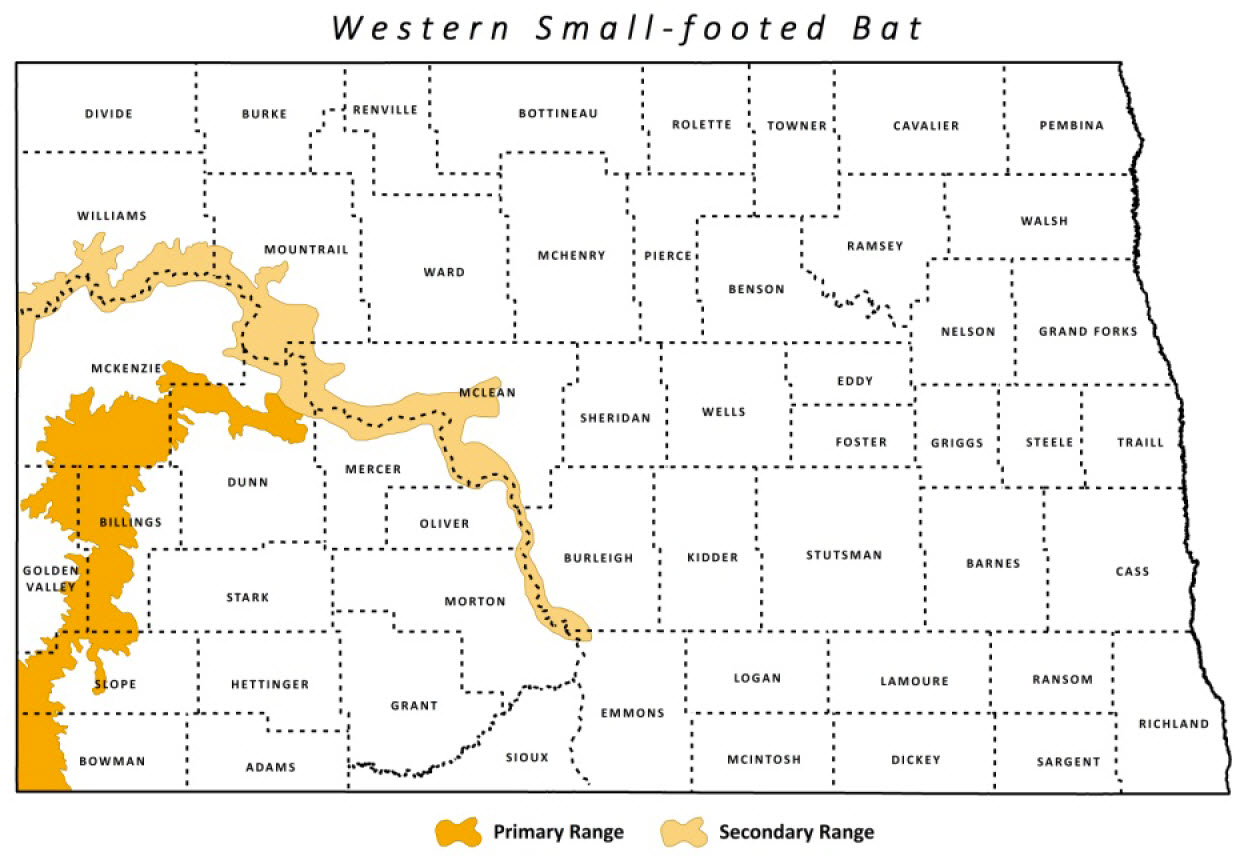
Western Small-footed Myotis
| Scientific Name | Myotis ciliolabrum |
|---|---|
| General Description | 4 inches from nose to tail and weighing .1-.2 ounces. Its pelage is pale yellowish brown and its ears and wing membranes are black. A black band of hair runs across both eyes, giving the appearance of a mask. |
| Status | Year-round, one of two species documented as hibernating in North Dakota. |
| Abundance | Rare |
| Primary Habitat | Documented in the riparian corridors of the Little Missouri and Missouri rivers. Normally found in rugged terrain they roost alone or in small groups in rock crevices and under tree bark. This species has a strong association with coniferous trees. |
| Federal Status | No federal status. |
| Reason for Designation | Little is known about this species in North Dakota. Although rare to the state there are some indications that it is declining range wide. |
Locations and Conditions of Key Habitat
Preferred Habitat
Western Small-footed Bat are found in areas with rock cliffs, clay buttes and steep slopes. Conifer trees are also associated with this species. Deep crevices are needed for hibernation.
Key Areas and Conditions for Western Small-footed Bat in North Dakota
Has been documented in the riparian corridors of the Little Missouri and Missouri rivers.
Problems Which May Affect this Species
Habitat
This and other bat species in the state rely on caves and crevices for hibernacula and maternal grounds. These sites are susceptible to human and other types of disturbance. Frequent disturbance may cause females to drop young in the rearing process or abandon the area. Loss and disturbance of roost habitat is a primary threat.
Other Natural or Manmade Factors
Western Small-footed Bat and other North Dakota bat species are insectivores. The use of pesticides in the vicinity of a feeding ground would affect bat populations by killing prey. Also, bat species are known to store pesticides within fat reserves. Loss of water sources is also a potential threat to this species. When natural water sources are dry, bats may resort to drinking from stock tanks, which can potentially trap bats. Wind turbines have been identified as a source of mortality to bats and several turbine “farms” are under construction in parts of North Dakota. Indiscriminate killing due to a negative public perception has been identified as a possible threat to this species.
Research and Survey Efforts
Current Research or Surveys
- Identification of hibernacula in western North Dakota as well as their susceptibility to White-nose Syndrome is being conducted North Dakota State University is currently developing a North Dakota Bat Management Plan.
Previous Research or Surveys
- A survey of bat species in the state was conducted by North Dakota State University.
- A number of agencies have surveyed for small mammals in the southwestern part of the state including, REAP, Theodore Roosevelt National Park, the U.S. Forest Service, and U.S. Bureau of Land Management.
Additional Research or Surveys Needed
- Research to assess primary threats to this species.
- Life History requirements for this species specific to North Dakota should be investigated.
- Document the effects of energy development on western bat species.
Management Recommendations
- Protection and restoration of riparian habitat.
- Manage riparian habitats to maintain snags, connecting corridors, and edges.
- Maintain and improve seeps, ponds, and other wet areas as water sources.
- Education on the benefits and misconceptions about bats.
- Determine and protect nursery and hibernation sites.
- Provide roosting sites in areas where natural sites have been destroyed or disturbed.
- Reduce use of pesticides near waterways where bats forage.
Monitoring Plans
monitoring protocol will be addressed in the North Dakota Bat Management Plan currently under development.
2005-2015 Progress
The Western Small-footed Myotis maintains its Level III Species of Conservation Priority ranking due to lack of information known about this species. SWG T2-5-R Distribution and Habitat Use of the Bats of North Dakota increased the information known for this species. Continued work is needed to address threats to this species and implementation of a monitoring plan.

Note: A listing of works consulted when compiling the information on this page may be found in the 2015 State Wildlife Action Plan.
